Understanding and Modeling the Effects of Task and Context on Drivers' Gaze Allocation
To further advance driver monitoring and assistance systems, it is important to understand how drivers allocate their attention, in other words, where do they tend to look and why. Traditionally, factors affecting human visual attention have been divided into bottom-up (involuntary attraction to salient regions) and top-down (driven by the demands of the task being performed). Although both play a role in directing drivers' gaze, most of the existing models for drivers' gaze prediction apply techniques developed for bottom-up saliency and do not consider influences of the drivers' actions explicitly. Likewise, common driving attention benchmarks lack relevant annotations for drivers' actions and the context in which they are performed. Therefore, to enable analysis and modeling of these factors for drivers' gaze prediction, we propose the following: 1) we correct the data processing pipeline used in DR(eye)VE to reduce noise in the recorded gaze data; 2) we then add per-frame labels for driving task and context; 3) we benchmark a number of baseline and SOTA models for saliency and driver gaze prediction and use new annotations to analyze how their performance changes in scenarios involving different tasks; and, lastly, 4) we develop a novel model that modulates drivers' gaze prediction with explicit action and context information. While reducing noise in the DR(eye)VE gaze data improves results of all models, we show that using task information in our proposed model boosts performance even further compared to bottom-up models on the cleaned up data, both overall (by 24% KLD and 89% NSS) and on scenarios that involve performing safety-critical maneuvers and crossing intersections (by up to 10--30% KLD). Extended annotations and code are available at https://github.com/ykotseruba/SCOUT.
PDF Abstract


 DR(eye)VE
DR(eye)VE
 BDD-A
BDD-A